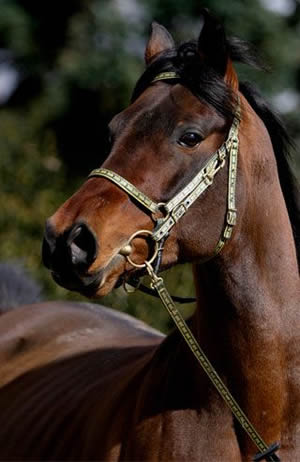History
The breed takes its name from the dapple-grey stallion Shagya, born in 1810. The Bani Saher tribe of Bedouins, who lived in what is now Syria, bred Shagya and sold him to agents of the Habsburg monarchy. In 1836, he became the breeding stallion at Babolna. Shagya was prepotent and appears in almost all Shagya pedigrees.
One of the purposes of the Shagya breed has always been as improvers of other breeds. Shagya stallions appear in the bloodlines of many warmblood breeds. The Shagya mare "Jordi" is the dam of the great warmblood stallion "Ramzes." "Ramzes" descendant "Rembrandt" won the 1988 Olympic Gold Medal for dressage.
Shagyas not only served as cavalry horses, they were also prized as parade horses by European royalty. The Imperial Guard of the Habsburgs was always mounted on Shagyas. Every royal officer regarded it as a privilege to be able to ride a Shagya. The toughness, courage, endurance and rideability of these horses was legendary among European horsemen. The motto of the Hungarian breeders was "Nothing but the best is good enough."
Shagya breeding in America officially began in 1986. The American foundation stallion was Hungarian Bravo, whose parents *Pilot (born at the Janow-Podlaski Stud in Poland in 1939) and *52 Gazall II (born at the Balbona State Stud in Hungary in 1937) were brought to America in 1947 under the direction of General Patton as prizes of war. Bravo began his purebred Shagya breeding career when he was 24 years old. He produced 3 sons and 11 daughters which are being used in Shagya breeding today. One of his sons is in Venezuela where he is helping to found Shagya breeding in South America.
The Horse was developed in the Austro-Hungarian Empire over 200 years ago. The breed originated from the need for a horse with the endurance, intelligence and character of an Arabian but with larger size and carrying capacity required by the Imperial Hussars. Over time, Shagyas were utilized both as carriage and light riding horses. The Shagya breed was originally developed at the Imperial Stud at Babolna, Hungary. Failed experiments with Spanish and Thoroughbred blood eventually led the breeders at Babolna to a cross of native Hungarian mares with stallions of pure Desert Arabian blood. Shagya bloodlines were also developed at the stud farms at Radautz (Hungary), Topolcianky (Czechoslovakia), Mangalia (Rumania), and Kabijuk (Bulgaria).






